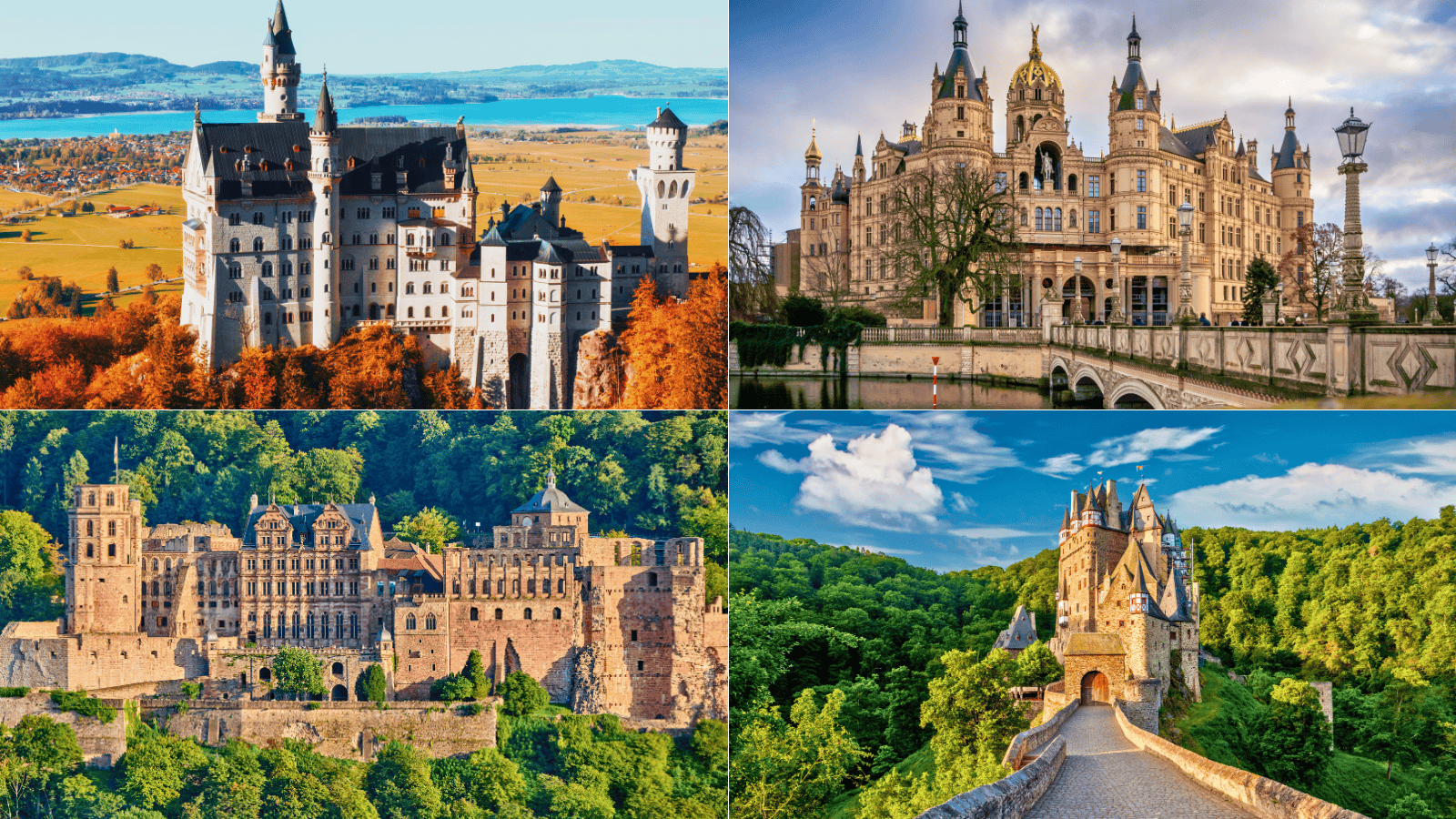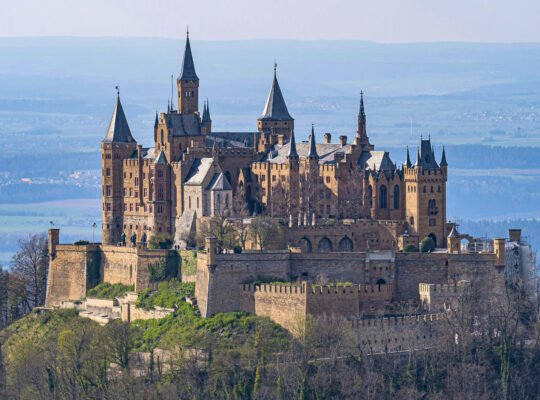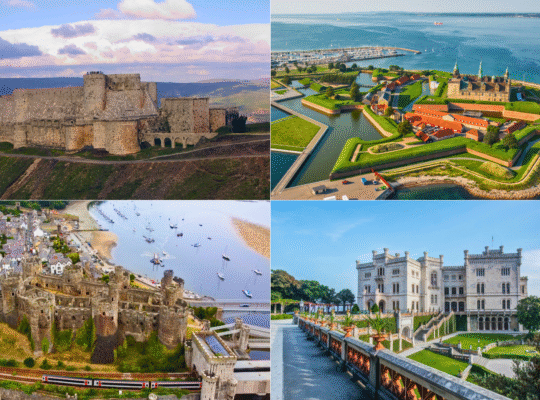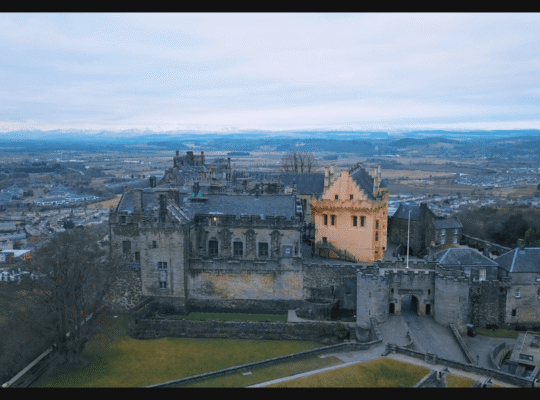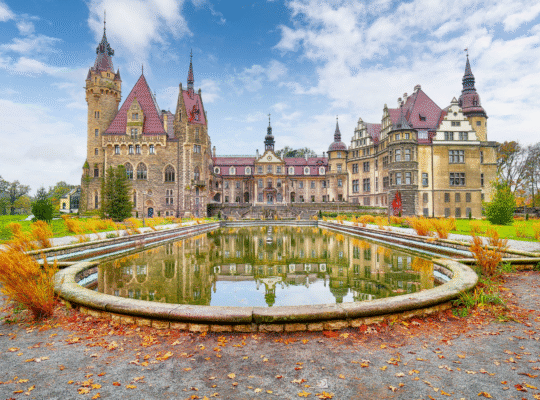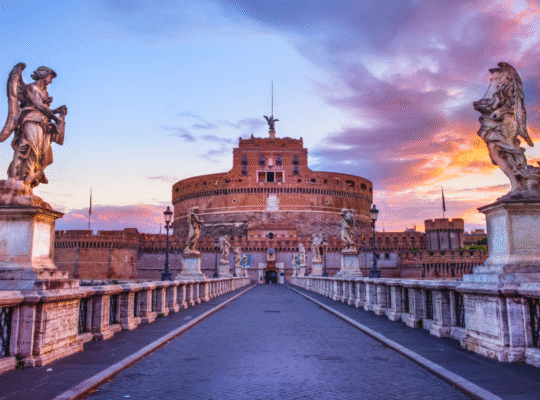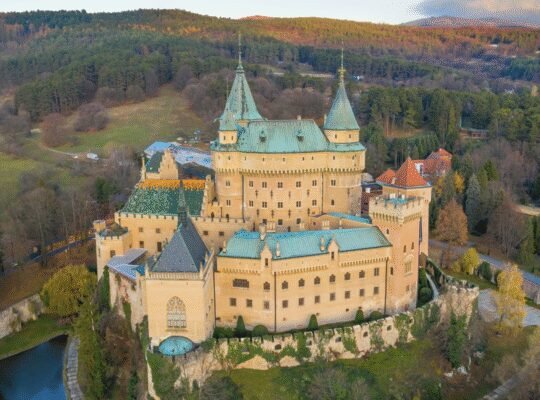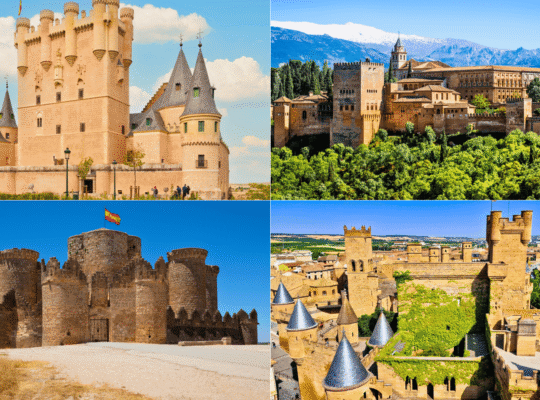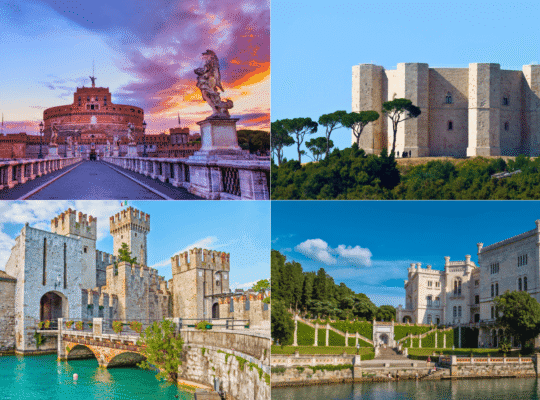I remember the first time I saw a German castle up close. My family and I had just driven through a sleepy Bavarian village when Neuschwanstein’s white towers suddenly appeared above the trees. For a second, I thought I was looking at a movie set. But this was real—just standing there, looking as dramatic as all the photos you see online.
Honestly, that first glimpse was a little overwhelming. There’s something about seeing a place you’ve only read about—or maybe spotted on a puzzle box—that just sticks with you. Suddenly, you’re not thinking about travel guides or bucket lists. You’re right there, feeling the history all around you.
If you’ve ever dreamed of wandering through ancient halls, gazing out from battlements, or tracing the footsteps of kings and rebels, Germany is the place to make those dreams real. This isn’t just a country of old walls and distant history—it’s a living, breathing patchwork of stories. Here, castles perch on river bends and craggy cliffs, hiding stories of mad kings, forbidden love, and fierce battles.
Curious about just how many castles dot the German landscape? According to the German National Tourist Board, there are more than 20,000 castles and palaces spread across the country—each with its own story.
But with so many options, where do you start? And how do you make the most of your trip—without missing the places that turn a vacation into a memory you’ll talk about for years? Whether you’re planning your first German adventure or looking to uncover new corners, I’ve pulled together the ten best castles in Germany to visit. Not just the famous icons, but the ones that made me stop, look twice, and linger just a little longer.
Ready for some castle magic, practical tips, and maybe a few surprises? Let’s dive in.

Germany’s Top 10 Castles at a Glance
| 🏰 Castle | 📍 Location | 🏗️ Era | 🎭 Famous For | 🎲 Fun Fact |
|---|---|---|---|---|
| Neuschwanstein Castle | Bavaria, near Füssen | 19th century (1869-86) | Storybook design, Ludwig II’s dream | Inspired Disney’s Sleeping Beauty castle |
| Heidelberg Castle | Baden-Württemberg, Heidelberg | 13th–17th centuries | Romantic ruins, hillside views | Site of Germany’s oldest wine barrel |
| Hohenzollern Castle | Baden-Württemberg, near Hechingen | 19th century (1850-67) | Neo-Gothic fortress, royal seat | Still privately owned by the Prussian royal family |
| Burg Eltz | Rhineland-Palatinate, Moselle | 12th–17th centuries | Intact medieval architecture | Never destroyed in war |
| Wartburg Castle | Thuringia, Eisenach | 11th century (1067) | Martin Luther’s refuge, UNESCO | Martin Luther translated the New Testament here |
| Schwerin Castle | Mecklenburg-Vorpommern, Schwerin | 19th century (1847-57) | Fairy-tale island palace | Said to be haunted by the ghost “Petermännchen” |
| Marksburg Castle | Rhineland-Palatinate, Braubach | 12th century (1117) | Rhine stronghold, UNESCO | Only Rhine castle never destroyed |
| Lichtenstein Castle | Baden-Württemberg, Swabian Alb | 19th century (1840-42) | Cliff-top views, “fairy-tale” look | Inspired by a best-selling novel |
| Cochem Castle | Rhineland-Palatinate, Cochem | 11th century, rebuilt 19th c. | River views, towers, legends | Was once pawned to pay a king’s debts |
| Nuremberg Castle | Bavaria, Nuremberg | 11th–16th centuries | Imperial history, city panoramas | Was the “center of the Holy Roman Empire” |

Neuschwanstein Castle
Quick Facts
| 📍 Location | Bavaria, near Füssen |
|---|---|
| 🏗️ Era | 19th century (1869–1886) |
| 🎭 Famous For | Storybook design, King Ludwig II’s vision |
| 🎲 Fun Fact | Inspired Disney’s Sleeping Beauty castle |
| 🏆 UNESCO Status | Not UNESCO-listed, but a candidate for future status |
| 🌐 Official Site | www.neuschwanstein.de |
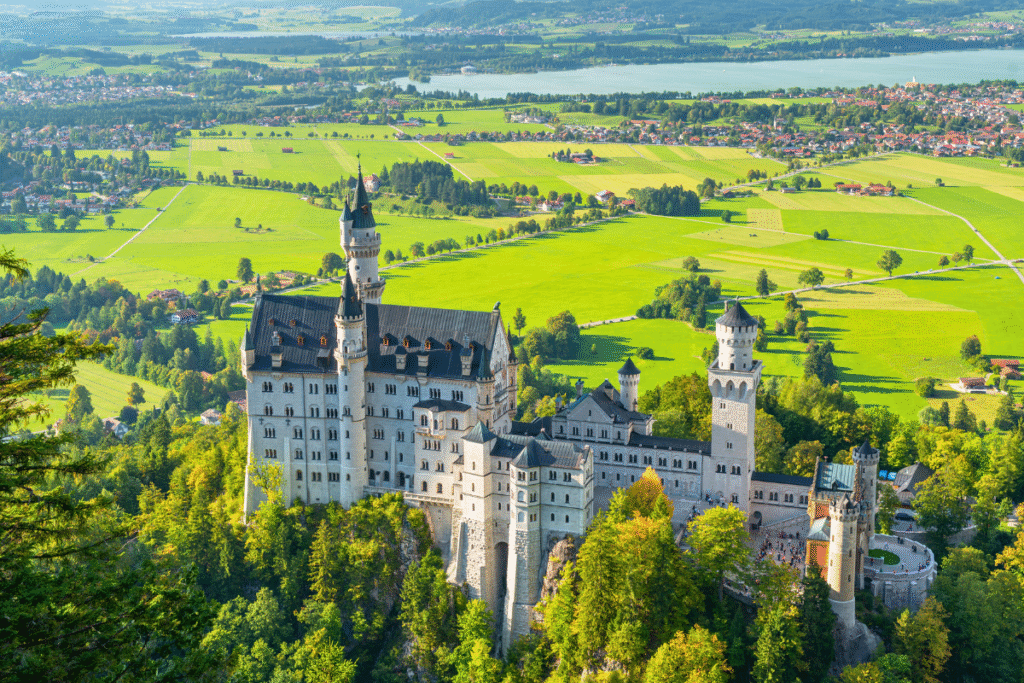
What It’s Like to See Neuschwanstein Up Close
There’s no way around it—Neuschwanstein is the kind of place that makes even locals stop and stare. I’ll admit, I half expected to be underwhelmed after seeing a million postcards. But that first walk up the wooded path, with those towers slowly coming into view above the treetops, felt like stepping right into a childhood daydream.
If you visit on a clear morning, the white walls seem to glow against the deep green pines. It’s quieter than you might expect, with birdsong and the crunch of gravel the only background noise. And once you catch sight of the castle from Marienbrücke (the little footbridge just behind), the whole thing feels surreal. That’s the view you’ll see all over Instagram—but honestly, in person, it’s even better.
A Quick History & a Hint of Madness
Neuschwanstein is less medieval fortress and more daydream brought to life. King Ludwig II started building it in 1869, not for defense, but as his private escape from royal life. Ludwig was obsessed with operas, legends, and castles, and he poured everything into this project—so much that people started calling him the “Fairy-Tale King.”
Ludwig barely lived here. In fact, he died mysteriously just weeks after moving in, leaving the castle unfinished. But even incomplete, it captured the imagination of visitors from the very start. Rumors and conspiracy theories about Ludwig’s end only add to the legend.
What Makes Neuschwanstein Unique?
Forget moats and arrow slits—this place is pure fantasy. The outside is all turrets, arches, and towers, but inside it’s a wild mix of grand halls, golden murals, and swan motifs everywhere (Ludwig was more than a little obsessed with swans).
Look for:
- The Throne Hall, which looks straight out of a medieval epic (even though it’s only about 140 years old)
- Ludwig’s own bedroom, carved with twisting woodwork and painted ceilings
- The “Grotto,” a strange fake cave built inside the castle just because Ludwig wanted it
If you love architecture, you’ll spot Romanesque, Gothic, and even Byzantine touches—sometimes all in the same room.
Visiting Neuschwanstein: Tips That Really Help
- How to Get There: Take a train to Füssen, then hop on a bus to Hohenschwangau village. From there, it’s either a steep 30-minute walk uphill, or you can catch a shuttle bus or horse-drawn carriage (expect lines in peak season).
- Tickets: Buy tickets in advance from the official site or at the ticket center in Hohenschwangau. Same-day tickets often sell out early, especially from April to October.
- Entry/Tours: Only guided tours are allowed inside, and they run in several languages. Tours last about 30–40 minutes.
- Best Time to Visit: Early morning or late afternoon for fewer crowds. Winter ❄️ is magical with snow, but trails can be slippery.
- Accessibility: The castle interior isn’t very accessible for wheelchairs or strollers—lots of stairs and uneven ground.
Nearby Attractions
- Hohenschwangau Castle (right next door—King Ludwig’s childhood home and worth a visit for the contrast alone)
- Alpsee Lake (great for a short hike or a picnic)
- Museum of the Bavarian Kings (for the full royal backstory)
- Füssen Old Town (charming, walkable, and less crowded than the main castle area)
Personal Note
Even after visiting dozens of castles, Neuschwanstein is the one I think about most. Sure, it gets crowded and can feel touristy at times, but nothing really prepares you for that first real-life glimpse. If you’ve ever wanted to step into a storybook—even just for an afternoon—this is the place.
If Neuschwanstein is at the top of your list, don't miss our in-depth Neuschwanstein Castle travel guide for planning tips, stunning photos, and all the practical info you need.

Heidelberg Castle
Quick Facts
| 📍 Location | Heidelberg, Baden-Württemberg |
|---|---|
| 🏗️ Era | 13th–17th centuries |
| 🎭 Famous For | Romantic ruins, hillside views |
| 🎲 Fun Fact | Home to the world’s largest wine barrel |
| 🏆 UNESCO Status | Not UNESCO-listed |
| 🌐 Official Site | www.schloss-heidelberg.de |
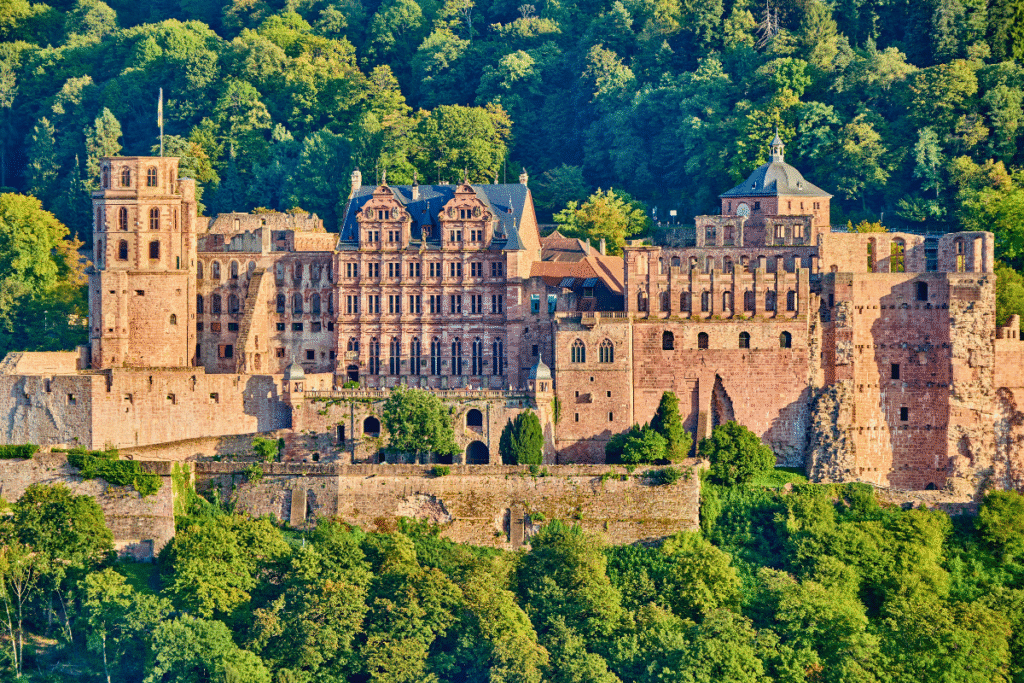
First Impressions: More Than Just a Ruin
Heidelberg Castle isn’t the kind of place you just stumble across. Perched high above the Neckar River, it seems to watch over the whole city like a silent guardian. My first time up there, I took the old funicular from the Altstadt and watched the red roofs of Heidelberg fall away beneath me. As the castle’s crumbling walls came into view, I realized—this is what people mean when they talk about “romantic ruins.”
Don’t expect a pristine palace. Heidelberg Castle wears its scars openly, thanks to centuries of wars, lightning strikes, and plain old bad luck. But that’s part of its charm. The place feels lived-in, layered with history and stories that you can almost hear on the wind.
A Castle Shaped by Fire and Fortune
The first castle rose here in the 1200s, but what stands today is a blend of Renaissance luxury and battle-scarred remains. It was expanded and rebuilt again and again—usually after being damaged by war or fire. The worst came during the War of the Grand Alliance in the late 1600s, when French troops did their best to wipe it off the map.
Through it all, Heidelberg Castle became a symbol of both German resilience and romantic nostalgia. Poets and painters made it famous in the 19th century, and even Mark Twain raved about it in his travel writings.
What’s Unique About Heidelberg Castle?
Heidelberg is all about atmosphere. Climb through archways overgrown with ivy, wander into half-ruined halls, and you’ll see why it’s inspired artists for centuries. A few things not to miss:
- The Great Tun: The world’s largest wine barrel, holding over 220,000 liters. You can actually climb up and walk on top.
- The Friedrich Building: Look for its ornate façade, statues, and windows—the best-preserved part of the palace.
- The Apothecary Museum: Hidden in the old cellars, this quirky museum tells the story of medicine and magic through the ages.
- Panoramic Terrace: For the best views of Heidelberg and the Neckar River valley.
Visiting Heidelberg Castle: Practical Tips
- How to Get There: Walk up from the Altstadt (it’s steep but scenic), or take the historic funicular railway from Kornmarkt.
- Tickets: Entry to the courtyard is free, but you’ll need a ticket for the interiors, the wine barrel, and the pharmacy museum. Tickets can be bought at the funicular station or online. Check the official website for the most up-to-date visitor information.
- Tours: Guided tours are available in English and German. Worth it for the extra stories and hidden details.
- Best Time to Visit: Late spring 🌸 and early autumn 🍂—fewer crowds and gorgeous light for photos. Evenings are especially atmospheric.
- Accessibility: The funicular is wheelchair-accessible, but many areas inside have cobblestones and stairs.
Nearby Attractions
- Heidelberg Old Town: Charming, full of cafes, boutiques, and the famous Alte Brücke (Old Bridge).
- Philosopher’s Walk: A peaceful hiking path on the opposite side of the river, with some of the best views of the castle.
- Student Prison: An odd but fun historical site, once used to punish unruly university students.
Personal Note
Heidelberg Castle might not be as polished as some others, but that’s exactly why I love it. There’s a raw, authentic feeling here. It’s easy to imagine students and poets gathering on the terrace, sipping wine and swapping stories. If you want to feel the weight of real history—and get a great view while you’re at it—don’t skip this stop.

Hohenzollern Castle
Quick Facts
| 📍 Location | Near Hechingen, Baden-Württemberg |
|---|---|
| 🏗️ Era | 19th century (1850–1867, third castle) |
| 🎭 Famous For | Neo-Gothic fortress, royal heritage |
| 🎲 Fun Fact | Still owned by the Hohenzollern family |
| 🏆 UNESCO Status | Not UNESCO-listed |
| 🌐 Official Site | www.burg-hohenzollern.com |

That First Glimpse: Straight from a Storybook (But Real)
There’s something about Hohenzollern Castle that grabs you before you even set foot inside. If you’re driving through the Swabian countryside, you’ll spot it from miles away—sitting on top of a perfectly shaped hill, wrapped in forest, looking like it landed straight from a movie set. Even after seeing dozens of castle photos, the real thing is a lot more dramatic.
My first visit was on a foggy morning, and the castle seemed to float above the clouds. It was almost eerie—one of those “Is this real?” moments. Whether the sun’s shining or there’s mist curling around the ramparts, Hohenzollern never feels ordinary.
A Royal Home Built (and Rebuilt) for the Ages
The Hohenzollern family—who eventually ruled Prussia and the German Empire—have called this spot home since the Middle Ages. The current castle is actually the third version, rebuilt in the 1800s when the family wanted something worthy of their royal status. They went all in: turrets, battlements, towers, and all the grandeur they could muster.
Today, the castle is still privately owned by the family, and you’ll spot their coat of arms throughout the grounds. You can even see the Prussian royal crown on display in the treasury—a reminder of just how important this dynasty once was.
What Makes Hohenzollern Stand Out?
This place is all about the views and the architecture. The approach is classic: a winding road, a stone bridge, and a dramatic entrance that makes you feel like you’re in a period film. Once inside, the Neo-Gothic design jumps out—think high ceilings, stained glass, and lavish halls.
Don’t miss:
- The Treasury: Rare jewels, silverware, and that famous royal crown.
- The Chapel: Small but beautifully decorated.
- The Ramparts: For panoramic views of the countryside—on clear days, you can see for miles.
- Seasonal Events: In winter, the castle sometimes hosts a Christmas market that’s pure magic.
Visiting Hohenzollern Castle: The Essentials
- How to Get There: Easiest by car—about an hour south of Stuttgart. There’s a large parking lot at the base; shuttle buses run up the hill (or you can walk, but it’s a steep climb).
- Tickets: Entry includes the courtyard, ramparts, and most rooms. Buy online in advance on the official website, especially during weekends and holidays.
- Tours: Audio guides in multiple languages. Check the schedule for special themed tours.
- Best Time to Visit: Spring 🌸 and autumn 🍂 for fewer crowds; early mornings for photos without people. The Christmas market (if running) is worth braving the chill.
- Accessibility: The shuttle and courtyard are accessible; the interiors have some stairs and uneven ground.
Nearby Attractions
- Hechingen Town: Cozy restaurants and bakeries, perfect for a pre- or post-castle meal.
- Roman Open-Air Museum: Explore ancient Roman ruins nearby.
- Swabian Alb Biosphere Reserve: Great for hiking and nature walks with castle views in the distance.
Personal Note
Every castle fan has a favorite “wow” moment, and for me, it’s the first look at Hohenzollern from below. The scale, the setting, the sheer drama—it never gets old. Whether you’re into royal history or just want a castle with unbeatable scenery, put this one high on your list.

Burg Eltz
Quick Facts
| 📍 Location | Moselle Valley, Rhineland-Palatinate |
|---|---|
| 🏗️ Era | 12th–17th centuries |
| 🎭 Famous For | Unspoiled medieval architecture, family home for 850+ years |
| 🎲 Fun Fact | Has never been destroyed in war |
| 🏆 UNESCO Status | Not UNESCO-listed, but on the UNESCO World Heritage tentative list |
| 🌐 Official Site | www.burg-eltz.de |
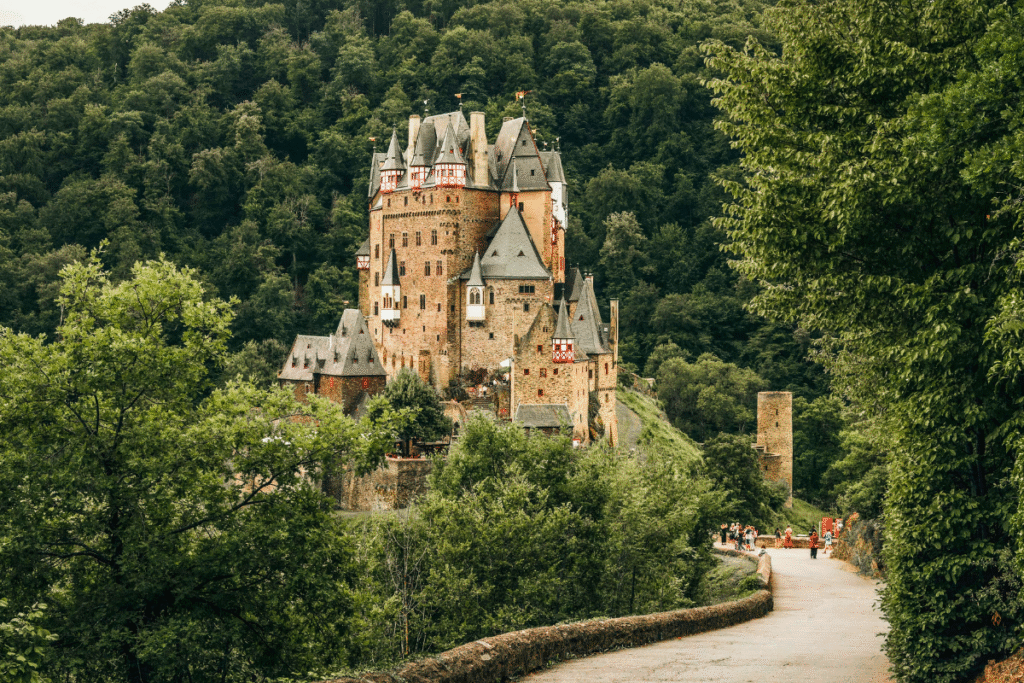
Stepping Into a Real-Life Fairytale
Burg Eltz isn’t the easiest place to reach, but that’s part of the charm. The first time I visited, the walk from the parking lot through thick woods built up the suspense. Then suddenly, there it was: a tangle of towers and timber beams rising above the river, hidden away in its own lush valley. It felt like stumbling on a secret.
No crowds, no noisy roads—just birds, trees, and this incredible fortress perched above the Elzbach River. If you ever wanted a castle that feels like it jumped right out of a storybook, this is it.
A Castle Untouched by Time (and War)
Burg Eltz has been in the hands of the same family for over 30 generations—a rare feat in Germany, where most castles saw battles, sieges, or fires. Eltz somehow avoided all of that. The result? An almost perfectly preserved slice of the Middle Ages, complete with family treasures and original furnishings.
You’ll hear stories of knights and nobles who once called Eltz home, and there’s plenty of legend too. My favorite: the tale of Countess Agnes, who defended the castle herself and is said to haunt its halls.
What Makes Burg Eltz Unique?
You can explore much of the interior on a guided tour. Highlights include:
- Medieval Bedrooms: Still filled with centuries-old tapestries, armor, and carved chests.
- Treasury and Armory: Home to gold goblets, fine jewelry, and weapons—some dating back to the Crusades.
- Inner Courtyard: A maze of balconies, pointed roofs, and half-timbered walls that make every angle photo-worthy.
- The Family Chapel: Tucked away in a quiet corner, surprisingly peaceful.
Because the Eltz family still lives here part-time, there’s a genuine sense of “home” that most castles have lost.
Visiting Burg Eltz: Practical Tips
- How to Get There: Closest towns are Moselkern and Münstermaifeld. Most visitors park at the official lot and either walk 15–20 minutes through the forest (downhill to the castle), or take a shuttle bus (runs in season).
- Tickets: Buy at the gate or online. Guided tours are included and required to see the interiors. Check the most up-to-date visitors' information on their official website.
- Tours: English and German available. Last about 40 minutes.
- Best Time to Visit: Late spring 🌸 and early autumn 🍂 for mild weather and smaller crowds. The castle is closed in winter (usually November–March).
- Accessibility: The walk can be steep and uneven. Not great for wheelchairs or those with mobility issues.
Nearby Attractions
- Moselle River Towns: Cochem and Koblenz, both full of charm, cafes, and river views.
- Geierlay Suspension Bridge: Germany’s most famous footbridge, perfect for a bit of adventure.
- Eltz Forest Hiking Trails: For those who love a peaceful woodland walk with castle views.
Personal Note
I’ve seen plenty of castles, but Burg Eltz has a quiet magic all its own. Maybe it’s the location, maybe it’s the sense of history you feel with every step. Whatever it is, this is one place I always recommend—especially if you want to escape the tourist crowds and feel like you’ve found something special.
Planning to see Burg Eltz for yourself? You’ll find practical details and personal insights in our full Eltz Castle travel guide.

Wartburg Castle
Quick Facts
| 📍 Location | Eisenach, Thuringia |
|---|---|
| 🏗️ Era | 11th century (founded 1067) |
| 🎭 Famous For | Martin Luther’s refuge, UNESCO site |
| 🎲 Fun Fact | Martin Luther translated the New Testament here |
| 🏆 UNESCO Status | Yes (since 1999) |
| 🌐 Official Site | www.wartburg.de |
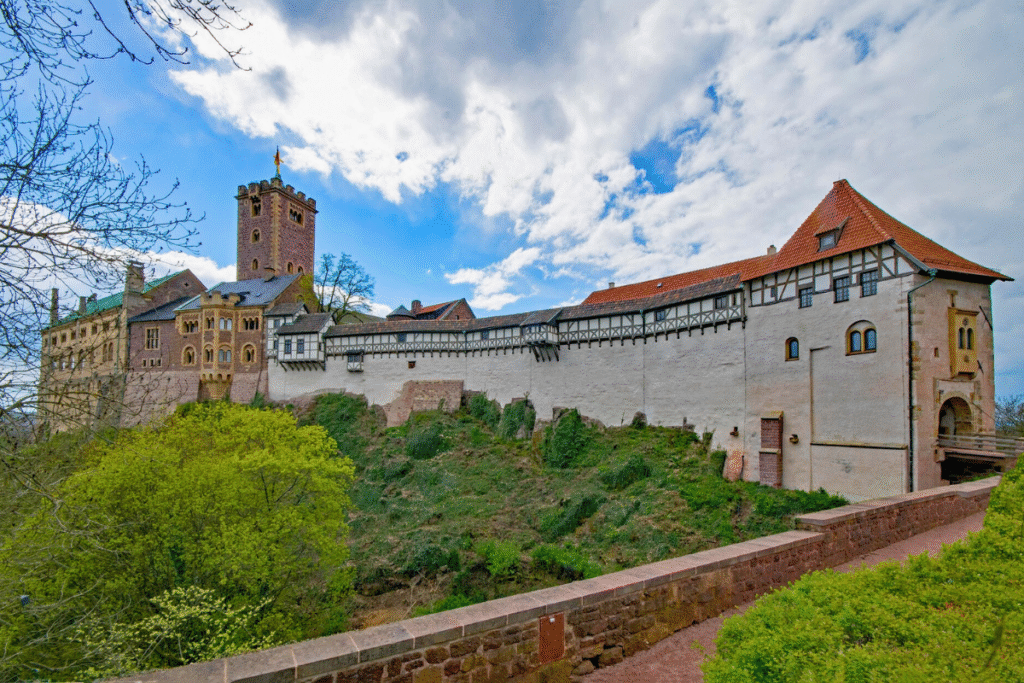
Why Wartburg Is Different: A Fortress on a Hill
Wartburg Castle isn’t just a landmark—it’s part of the German national story. Sitting high above Eisenach, you can spot its outline from miles away. My own visit started with a winding drive up the forested hill, and I was struck by how solid and self-contained it felt. This place doesn’t just look strong; it’s been the backdrop for real turning points in history.
The views from the ramparts are something else—rolling forests, distant villages, and, if you catch the right light, a golden haze that makes it easy to imagine poets and kings staring out from these same walls.
A History That Changed the World
Wartburg’s story stretches back nearly a thousand years. It was once home to the legendary minnesingers (medieval singers and poets), and later became the hideout for Martin Luther. Fleeing persecution, Luther spent months here disguised as “Junker Jörg,” translating the New Testament into German—a move that changed the country forever.
But Wartburg isn’t just about Luther. The castle was the stage for medieval singing contests, dramatic sieges, and even Germany’s first major student protest in 1817. Its thick stone walls have seen just about everything.
What Makes Wartburg Castle Special?
This is a rare castle where you can walk through the centuries—Romanesque towers, Renaissance halls, and rooms decked out in late 19th-century style.
Highlights include:
- The Luther Room: Where Martin Luther did his groundbreaking translation work (the original desk and chair are on display).
- The Knights’ Hall: Massive beams and stained glass set the scene for medieval banquets and gatherings.
- The Elisabeth Bower: Named after Saint Elisabeth, who lived here as a princess and became famous for her acts of charity.
- Castle Museum: With everything from armor to paintings and artifacts found on-site.
UNESCO called Wartburg “an outstanding monument of the feudal period in central Europe”—and once you’re there, it’s easy to see why.
Visiting Wartburg Castle: What You Need to Know
- How to Get There: Eisenach is reachable by train; from town, it’s a steep but scenic walk up (or you can take a shuttle bus or taxi).
- Tickets: Buy at the castle or online on their official website. Different ticket options for the museum, special exhibitions, and guided tours.
- Tours: Guided tours (English and German) add great context; audioguides available for self-paced visits.
- Best Time to Visit: Spring 🌸 and early autumn 🍂 for nice weather and clear views. The castle is open year-round, but winter visits have their own cozy charm.
- Accessibility: The main courtyard is accessible by shuttle, but many interiors have stairs and uneven floors.
Nearby Attractions
- Bach House: Museum devoted to composer Johann Sebastian Bach, who was born in Eisenach.
- Drachenschlucht (Dragon’s Gorge): A narrow, scenic hiking trail just outside town.
- Automobile Welt Eisenach: For car buffs, a look at local auto history.
Personal Note
Wartburg was one of those places that surprised me. I expected history, but the atmosphere—half fortress, half storybook—caught me off guard. You don’t just see the past here, you feel it in the walls, the wooden beams, even the chilly stairways. Whether you’re a history fan, a Luther buff, or just want a classic castle view, Wartburg is a must-see.

Schwerin Castle
Quick Facts
| 📍 Location | Schwerin, Mecklenburg-Vorpommern |
|---|---|
| 🏗️ Era | 19th century (current palace 1847–1857) |
| 🎭 Famous For | Island setting, fairytale architecture |
| 🎲 Fun Fact | Said to be haunted by the ghost “Petermännchen” |
| 🏆 UNESCO Status | On Germany’s tentative UNESCO list |
| 🌐 Official Site | www.schloss-schwerin.de |
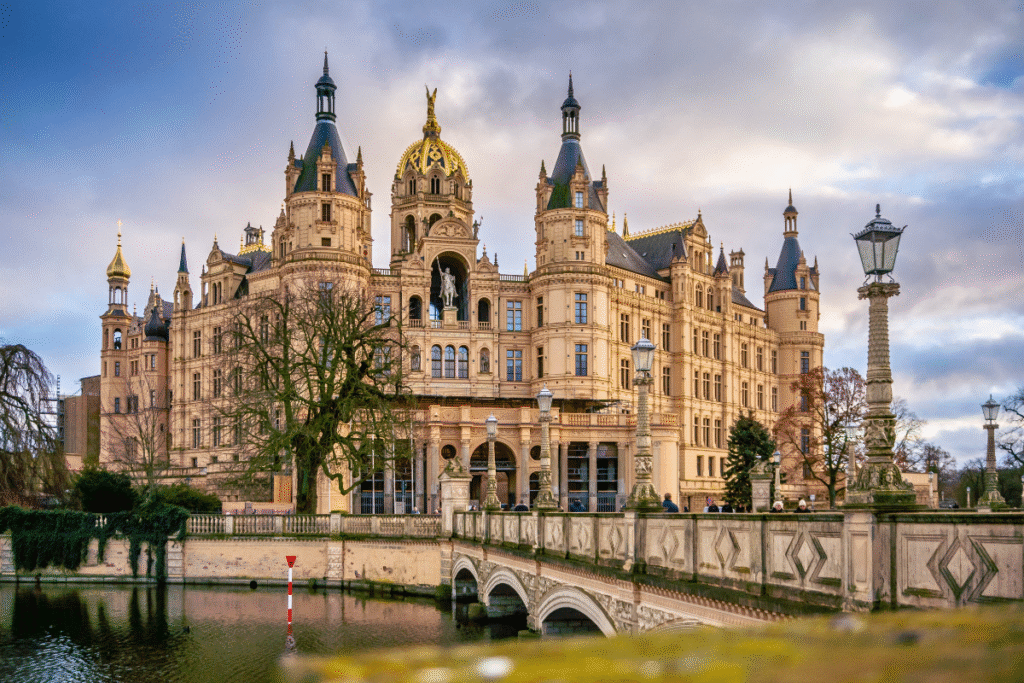
An Island Palace That Feels Almost Surreal
Schwerin Castle is one of those places that seems to belong in a fantasy film. Surrounded by lakes and gardens, the castle sits on its own island in the middle of Schweriner See. The approach—crossing the bridge with the palace’s golden towers rising ahead—never fails to impress.
The first time I saw Schwerin, I actually stopped in my tracks. The combination of water, ornate facades, and sprawling parkland felt almost unreal. It’s a palace, but there’s something approachable about it—like it’s always waiting for visitors, not just royalty.
History: From Fortress to Grand Palace
There’s been a fort on this spot since the 10th century, but the Schwerin Castle you see today was built for the Grand Dukes of Mecklenburg in the 19th century. Inspired by the Loire Valley châteaux in France, architects went all out: soaring spires, grand halls, and details everywhere you look.
It’s not just a showpiece, either. Schwerin Castle has served as a ducal residence, a military hospital, and now houses the state parliament. And then there’s the castle’s most famous resident: Petermännchen, a legendary ghost who’s said to protect the palace from harm (and play the occasional prank).
What Makes Schwerin Castle Unique?
The setting is unbeatable—almost completely surrounded by water, with gardens and bridges everywhere. Inside, the rooms are filled with gilded ceilings, painted murals, and sparkling chandeliers.
Don’t miss:
- The Throne Room: With its marble columns and gold detailing, it’s a true showstopper.
- Castle Museum: Displays art, porcelain, and personal treasures of the dukes.
- Orangery and Gardens: Perfect for a picnic or just a stroll.
- Ghost Stories: Look for hints of Petermännchen—the castle even sells little souvenirs of him.
The castle’s exterior is just as striking as what’s inside, so save plenty of time for wandering the grounds and taking photos from all angles.
Visiting Schwerin Castle: Need-to-Know Tips
- How to Get There: Schwerin is about an hour by train from Hamburg or Rostock. From the train station, it’s a 15-minute walk through the old town to the castle.
- Tickets: Purchase on-site or online. Entry includes the museum and selected state rooms; gardens are free to explore. Check their official website for the most up-to-date visitors' information.
- Tours: Audioguides and scheduled guided tours (English/German) provide a rich background.
- Best Time to Visit: Late spring 🌸 through early autumn 🍂—gardens are in bloom, and you can picnic on the lakeshore.
- Accessibility: The main museum is accessible, but some historic rooms and towers have stairs.
Nearby Attractions
- Schwerin Old Town: Cobblestone streets, quaint cafes, and plenty of local shops.
- Schwerin State Museum: Art lovers will enjoy the collection of Dutch and German masters.
- Pfaffenteich Lake: Just a few minutes’ walk, great for a scenic boat ride or coffee by the water.
Personal Note
Schwerin Castle is one of those places I always recommend to friends looking for something “different.” It has all the elegance of a royal palace, but with the relaxed vibe of a small town. Add in the lakeside setting and just a hint of ghostly mischief, and you’ve got one of Germany’s best castle experiences.

Marksburg Castle
Quick Facts
| 📍 Location | Braubach, Rhineland-Palatinate |
|---|---|
| 🏗️ Era | 12th century (first mentioned in 1117) |
| 🎭 Famous For | Unspoiled medieval stronghold, UNESCO site |
| 🎲 Fun Fact | Only castle on the Middle Rhine never destroyed |
| 🏆 UNESCO Status | Yes (Upper Middle Rhine Valley) |
| 🌐 Official Site | www.marksburg.de |
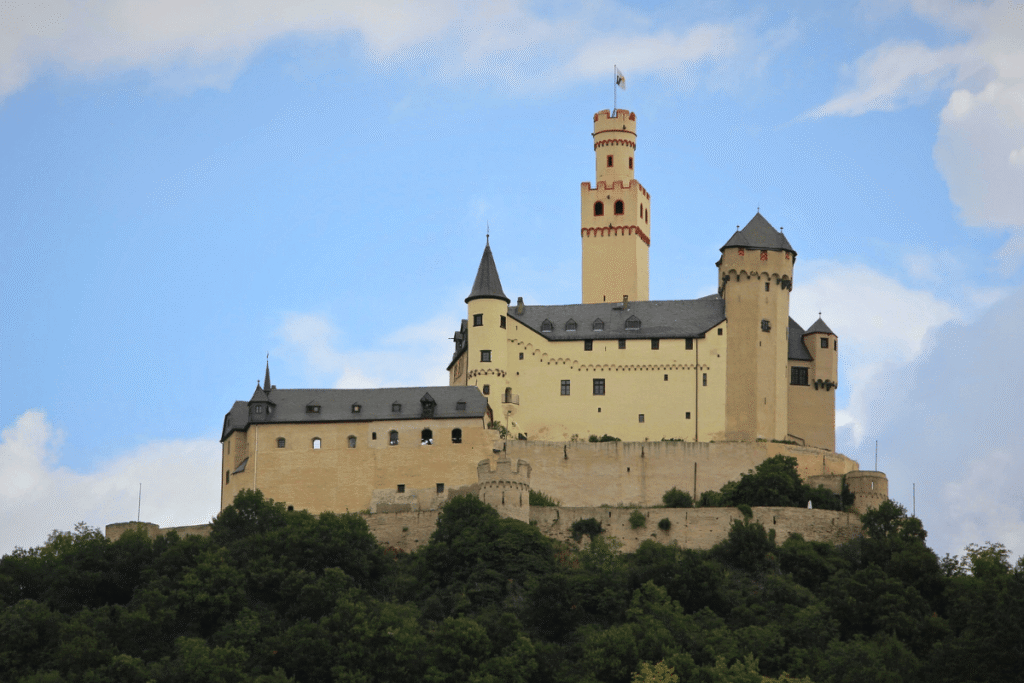
A Fortress Meant for Battle, Not Beauty
Some castles were built to impress—Marksburg was built to survive. Towering above the Rhine on a steep hill, it looks just as intimidating today as it did 800 years ago. My first visit was on a chilly fall morning. There was mist rising from the river, and I could almost imagine lookouts keeping an eye out for trouble on the horizon.
If you want a castle that looks and feels like it did in the Middle Ages, this is it. Marksburg isn’t fancy. There are no glittering halls or royal bedrooms, but every wall, staircase, and arrow slit tells a story of knights, sieges, and old-school castle life.
History: The Last Survivor
Marksburg has guarded the Rhine since the 12th century and—unlike almost every other castle in the region—was never conquered or destroyed. Over the years, it changed hands between noble families, with each adding their own touches, but always keeping the fortress ready for battle.
It’s now the headquarters of the German Castle Association, which works to protect castles all over the country. If you’re curious about how castles really worked (and survived), Marksburg is the ultimate classroom.
What Makes Marksburg Castle Unique?
Marksburg is all about authenticity. You won’t find any modern renovations—just stone walls, twisting staircases, and rooms that show off real medieval life.
Highlights include:
- The Battery Tower: Packed with cannons, armor, and original weapons.
- Castle Kitchen and Chapel: See how people ate, prayed, and gathered centuries ago.
- Torture Chamber: Not for the faint of heart, but very real.
- Medieval Bedrooms: Complete with straw mattresses and period details.
- Viewpoints: Panoramic views of the Rhine that make for great photos in any season.
Marksburg’s walls, towers, and winding passages feel unchanged by time.
Visiting Marksburg Castle: Your How-To Guide
- How to Get There: Braubach is a small town on the Rhine, reachable by regional train from Koblenz or Mainz. From the station, it’s a steep 15–20 minute walk uphill to the castle.
- Tickets: Buy at the gate or online. All visits are by guided tour (included in the ticket). Check the most up-to-date visitors' information on their official website.
- Tours: Guided tours available in English and German, lasting about 50 minutes. Tours run frequently.
- Best Time to Visit: Spring 🌸 and autumn 🍂 for mild weather; the castle is open year-round, but check for holiday closures.
- Accessibility: Lots of stairs and uneven ground—tough for wheelchairs or strollers.
Nearby Attractions
- Rhine River Cruises: Many stop at Braubach and offer stunning castle views along the river.
- Braubach Old Town: Quiet streets, historic half-timbered houses, and cozy restaurants.
- Nearby Castles: Stolzenfels and Lahneck are close if you’re on a castle spree.
Personal Note
Marksburg was a surprise for me. I thought I’d seen “real” castles before, but this one feels like stepping into the past—no frills, no modern gloss, just honest medieval grit. If you want to feel what castle life was actually like, Marksburg should be on your list.

Lichtenstein Castle
Quick Facts
| 📍 Location | Swabian Jura, Baden-Württemberg |
|---|---|
| 🏗️ Era | 19th century (1840–1842) |
| 🎭 Famous For | Dramatic cliff-top setting, “fairy-tale” look |
| 🎲 Fun Fact | Inspired by a bestselling novel |
| 🏆 UNESCO Status | Not UNESCO-listed |
| 🌐 Official Site | www.schloss-lichtenstein.de |

The Castle That Looks Impossible
Lichtenstein Castle is one of those places you need to see in person to believe. It isn’t huge, and it doesn’t have centuries of royal history, but its location is pure drama: perched right on the edge of a limestone cliff, overlooking miles of forest and valley. The first time I walked across the wooden bridge to the entrance, I stopped just to take it all in—turrets and towers, sheer drop below, and nothing but open sky all around.
It feels a bit like a movie set, except it’s very real—and far quieter than most of Germany’s famous castles. Lichtenstein may not be as crowded, but it’s every bit as photogenic.
Born from a Book: A Novel Castle
Unlike most castles on this list, Lichtenstein is a newcomer. It was built in the 1840s by a duke who fell in love with a novel called “Lichtenstein” by Wilhelm Hauff. The book tells the story of knights, daring rescues, and medieval romance. Inspired, Duke Wilhelm decided to build his own fantasy castle on the ruins of an older fortress.
The result? A pocket-sized palace that feels tailor-made for fairy tales—pointed spires, stained glass, and every architectural detail picked for drama. It’s still owned by the duke’s descendants, and their family crest greets you at the entrance.
What Makes Lichtenstein Castle Unique?
Every corner of Lichtenstein Castle is designed for maximum impact—especially the views. Don’t miss:
- Wooden Drawbridge: Suspended over the cliff, it’s the only way in or out.
- Knight’s Hall: Complete with armor, banners, and dark wood paneling.
- Chapel and Courtyard: Intimate, with colorful stained glass and carvings.
- Panoramic Balcony: For sweeping views of the Echaz Valley and the Swabian Alps.
It’s not huge, but every room is packed with personality.
Visiting Lichtenstein Castle: Tips for a Smooth Visit
- How to Get There: The castle is near Honau; best reached by car. There’s a parking lot a short walk from the entrance, and bus connections from Reutlingen and other local towns.
- Tickets: Buy on-site; guided tours are required to enter the interiors and are offered in German, with English info sheets available. Check their official website for the most up-to-date visitors' information.
- Tours: Last about 30–40 minutes and cover most of the castle’s main rooms.
- Best Time to Visit: Spring 🌸 and fall 🍂 for bright skies and green valleys; early summer for wildflowers in the surrounding woods.
- Accessibility: Some stairs and uneven paths; the courtyard and grounds are easier to navigate than the interior.
Nearby Attractions
- Bear Cave (Bärenhöhle): Family-friendly cave system, fun for kids and geology buffs.
- Swabian Alps Hiking Trails: Miles of trails with castle views and picnic spots.
- Reutlingen: A lively small city with good food and shopping.
Personal Note
Lichtenstein Castle doesn’t get the crowds of Neuschwanstein or Heidelberg, but that’s honestly part of its charm. If you want photos with epic views—and a real storybook vibe—this is one place that feels like a hidden treasure. Don’t be surprised if you end up staying longer than you planned.

Cochem Castle
Quick Facts
| 📍 Location | Cochem, Rhineland-Palatinate |
|---|---|
| 🏗️ Era | 11th century (rebuilt in the 19th century) |
| 🎭 Famous For | Dramatic river views, fairy-tale towers |
| 🎲 Fun Fact | Once pawned to pay a king’s gambling debts |
| 🏆 UNESCO Status | Not UNESCO-listed (but in a World Heritage region) |
| 🌐 Official Site | www.burg-cochem.de |
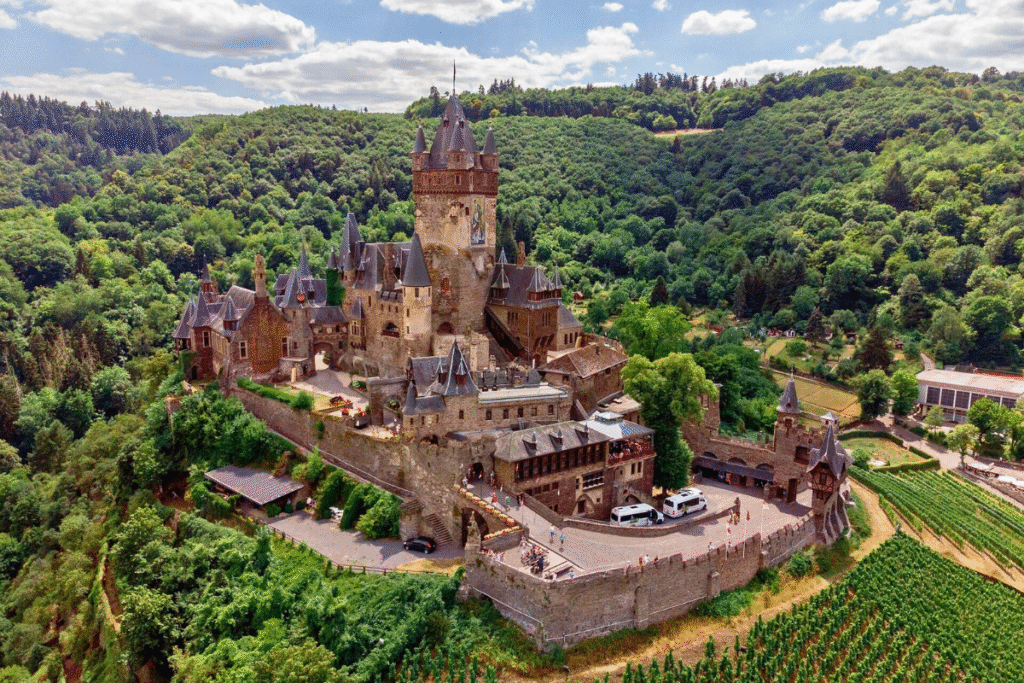
A Castle Above the Vineyards
There’s something timeless about Cochem Castle, perched high above the town and the winding Moselle River. You’ll spot it from miles away—turrets and battlements rising above steep vineyards and medieval streets. My favorite moment is the climb up from town; it’s a short, steep walk, and every turn gives you a new angle on those impossibly photogenic towers.
The castle itself feels lively—maybe because the town below is always buzzing with river cruises, wine festivals, and cyclists passing through. Even on a rainy day, the view from the ramparts over the Moselle Valley is hard to beat.
From Ruins to Revival
Cochem’s original castle was built around the year 1000, but like so many castles along the river, it didn’t escape trouble. In the late 17th century, French troops blew it up during one of Europe’s endless wars. For almost 200 years, the ruins stood as a symbol of lost grandeur—until a Berlin businessman bought the whole hilltop in the 1800s and decided to rebuild, full storybook style.
The “new” Cochem Castle is an honest-to-goodness romantic fantasy—pointed spires, arched windows, and grand halls, all inspired by the medieval look but with a cozy, welcoming vibe.
What Makes Cochem Castle Stand Out?
A visit here is as much about the setting as the castle itself. Cochem is the kind of place where you want to take your time, stroll the terraces, and just enjoy being surrounded by wine country.
Don’t miss:
- Guided Tours: The only way inside; you’ll get stories, castle history, and a peek into furnished rooms (some are surprisingly opulent).
- The Courtyard: Great spot for photos with those iconic towers.
- Castle Café: Perfect for coffee or a slice of cake with river views.
- Falconry Shows: Seasonal events where you can see birds of prey up close.
If you’re lucky, you might catch one of the castle’s medieval banquets or special festivals.
Visiting Cochem Castle: What You Need to Know
- How to Get There: Cochem is easily reached by train (from Koblenz or Trier), and the walk to the castle from the station or town center is about 20 minutes uphill. Taxis and shuttles also run in season.
- Tickets: Sold at the gate. All visits to the interiors are by guided tour (German and English available). Check the official website for the most up-to-date visitors' information to plan your visit.
- Tours: Last about 40 minutes, with a mix of history and fun legends.
- Best Time to Visit: Late spring 🌸 through early autumn 🍂 for the best views and events. The castle is open most of the year, but check hours in winter.
- Accessibility: The walk is steep and cobbled, and there are stairs inside—less suitable for wheelchairs or strollers.
Nearby Attractions
- Moselle River Cruises: Scenic rides past vineyards and more castles.
- Old Town Cochem: Timbered houses, wine taverns, and a lively main square.
- Wildlife Park: Just outside town, fun for families.
- Other Moselle Castles: Burg Eltz is not far, if you want a two-castle day.
Personal Note
Cochem Castle always feels festive to me. Maybe it’s the wine, the river, or the fact that the whole town seems built for slow travel and good times. Whether you’re a castle fan or just looking for a great place to relax, this is a stop that delivers both history and heart.

Nuremberg Castle
Quick Facts
| 📍 Location | Nuremberg, Bavaria |
|---|---|
| 🏗️ Era | 11th–16th centuries |
| 🎭 Famous For | Imperial power, panoramic city views |
| 🎲 Fun Fact | Was once the seat of the Holy Roman Emperors |
| 🏆 UNESCO Status | Not UNESCO-listed |
| 🌐 Official Site | www.kaiserburg-nuernberg.de |
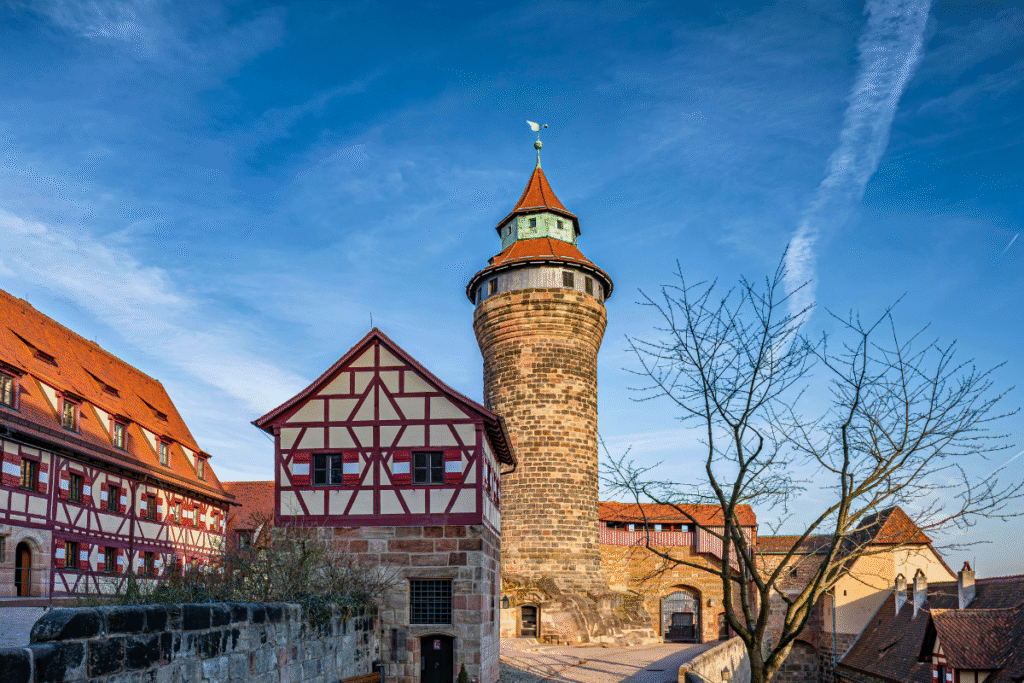
The Heart of Old Nuremberg
There’s no missing Nuremberg Castle. Its stone towers and walls dominate the skyline above the Altstadt, and walking up through the old town’s cobblestone streets, you feel the city’s medieval heartbeat. My first time here was on a winter afternoon; the castle loomed above the snowy rooftops, and I could see why emperors chose this spot to rule.
Climbing up to the castle is a rite of passage in Nuremberg—kids, grandparents, and travelers all take the winding path past old city gates and timbered houses. By the time you reach the top, the view is your reward: a sea of red roofs and church spires stretching in every direction.
A Fortress of Power
Nuremberg Castle was much more than just a residence. For centuries, it was the seat of the Holy Roman Emperors, who traveled from castle to castle across their domain. From the 11th century onwards, this stronghold was a symbol of power, prestige, and sometimes, drama.
During World War II, the castle was heavily damaged, but careful restoration brought back its historic glory. Today, you’ll find medieval halls, imperial apartments, and exhibitions on how the emperors lived, traveled, and ruled.
What Makes Nuremberg Castle Special?
Nuremberg Castle is big—you could easily spend a few hours here and still not see it all.
Don’t miss:
- Deep Well: An original 50-meter-deep well, with demonstrations on how water was drawn up in medieval times.
- Sinwell Tower: Climb to the top for the best city views (especially pretty at sunset).
- Imperial Chapel: Simple but historic, with original Romanesque details.
- Museum: Artifacts from all over Europe, showing Nuremberg’s importance as a trading and political hub.
The castle grounds also make for a peaceful walk—even during the busy Christmas market season, there are quiet corners to enjoy.
Visiting Nuremberg Castle: Tips and Insights
- How to Get There: Located right in Nuremberg’s old town, just a 10–15 minute walk from the main train station or Hauptmarkt (central square).
- Tickets: Buy at the entrance. Separate tickets for the main museum and tower, or a combo ticket for all areas. Check the official website for the most up-to-date visitors' information to plan your visit.
- Tours: Audioguides in multiple languages; check the website for special themed tours.
- Best Time to Visit: Open year-round. Spring 🌸 and fall 🍂 are ideal for good weather and lighter crowds; December is magical with Christmas markets.
- Accessibility: Most exterior paths are paved, but towers and some halls have stairs.
Nearby Attractions
- Albrecht Dürer’s House: Home and museum of the famous Renaissance painter, just steps from the castle.
- Nuremberg Toy Museum: A hit for families and nostalgia fans.
- Hauptmarkt: Central square known for its lively markets and street food.
- Documentation Center Nazi Party Rally Grounds: For those wanting to dig deeper into history.
Personal Note
Nuremberg Castle might not have the fairy-tale look of Neuschwanstein, but if you want history you can feel—and some of the best views in Bavaria—this is a must. There’s something powerful about standing where emperors once plotted and planned, looking out over a city that has seen it all.

Which Castle Is Best For You?
With so many options, it’s easy to get overwhelmed. The truth is, each of Germany’s top castles has its own personality—and some are a better fit depending on what you’re hoping to experience. Here’s how to choose, plus a few sample routes for your next adventure.
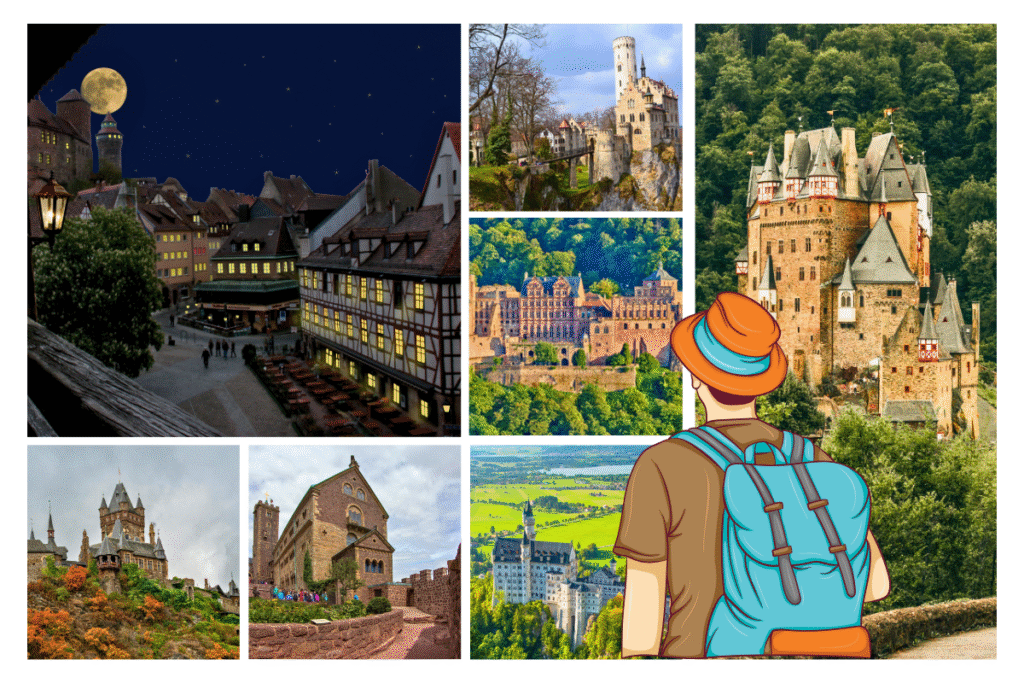
Quick Picks: Find Your Perfect Castle
For the Fairytale Seeker:
Neuschwanstein Castle is the clear winner. If you want that “storybook” feeling—complete with turrets, mountain views, and the sense you’re starring in your own movie—this is the one. Lichtenstein Castle is a great second choice if you love hidden gems.
For Medieval Purists:
Marksburg Castle and Burg Eltz are as authentic as it gets. Both have survived centuries without being destroyed, and every room feels like the Middle Ages are still alive.
For History Lovers:
Wartburg Castle is steeped in German history, from Martin Luther to medieval minnesingers. Nuremberg Castle is perfect for fans of imperial intrigue and those who want a taste of city history too.
For Romantic Ruins and Atmosphere:
Heidelberg Castle is hard to beat, especially at sunset or when the mist rolls in over the Neckar valley. Bring a camera—and maybe a bottle of local wine.
For Families and Kids:
Cochem Castle offers guided tours with a touch of humor and fun, plus falconry shows. Schwerin Castle and its gardens are also fantastic for a relaxed day out.
For Photographers:
Schwerin Castle’s lakeside setting and Neuschwanstein’s mountain backdrop are unbeatable for stunning photos in any season. Don’t miss sunrise or sunset for the best light.
For Off-the-Beaten-Path Adventurers:
Lichtenstein Castle and Marksburg Castle are both less crowded, so you can soak up the atmosphere without tour bus groups. Hikers will love the surrounding trails too.
Sample Castle Itineraries
Classic Southern Germany Route (4–5 days):
- Start in Munich or Stuttgart.
- Visit Neuschwanstein Castle (near Füssen).
- Continue to Hohenzollern Castle.
- End with Lichtenstein Castle and, if you have time, the Black Forest.
Rhine Valley Castle Crawl (2–3 days):
- Start in Koblenz.
- Tour Marksburg Castle in Braubach.
- Add Burg Eltz and Cochem Castle (with scenic Moselle River drives between).
- Great for combining wine tastings, boat rides, and short hikes.
History and Culture Loop (3–4 days):
- Start in Frankfurt or Nuremberg.
- Explore Heidelberg Castle and its old town.
- Head to Nuremberg Castle and nearby museums.
- Add Wartburg Castle for a powerful finish in Eisenach.
Northern Beauty (2 days):
- Head north for Schwerin Castle—combine with a night in the pretty town and walks around the lakes.
Tips for Combining Castles:
- Germany’s trains connect most major cities and many small towns, but a car gives the most flexibility—especially for castles in the countryside.
- If you’re short on time, pick one region and dig deep. Most castles deserve at least half a day.
- Check opening dates, as some (like Burg Eltz) close in winter.
General Advice
- Consider buying tickets online in advance, especially for Neuschwanstein and Burg Eltz.
- Guided tours add a lot, even for seasoned travelers—there’s always a hidden detail or wild story.
- Don’t rush! Many castles are surrounded by nature, charming villages, or hidden cafes worth exploring.
No matter which castles you choose, you’ll end up with memories (and photos) that last a lifetime.

Final Thoughts
Standing on a castle wall, looking out over forests, rivers, or rooftops, you start to understand why people keep coming back to these places. Germany’s castles aren’t just relics—they’re part of daily life and living history. Each one has its own character. Some feel grand, others mysterious, some simply welcoming. I’ve left every castle on this list with a camera full of photos and at least one new story to tell.
If you’re planning your own castle trip, remember: don’t try to rush through them all. Pick a few that really spark your interest. Give yourself time to wander the gardens, peek into quiet corners, and maybe sit with a coffee or a local beer, just soaking it all in.
And one more thing—every traveler finds their own favorite. Maybe it’ll be the famous spires of Neuschwanstein, or maybe a hidden corner in the shadows of Marksburg. The real magic is that these places make you feel something, even long after you’ve left.
Have you explored any of these German castles—or discovered one I missed? I’d love to hear your stories, see your favorite castle photos, or even just chat travel plans. Drop a comment 💬 below, or tag us 👻 on Instagram @CastleQuestChronicles so others can get inspired too!
For more on Germany’s most iconic castles, see the German National Tourist Board’s website.
👉 Love castles as much as we do? Don’t miss our guides to the best castles in England, in the Loire Valley in France, and across Europe—there’s always another adventure waiting.
Happy castle hunting.
📸 And if this article sparked your curiosity about the castles, follow along. We are on Instagram, Pinterest, Facebook, and X, too. More castles (and more stories) are just around the bend. Explore all our castle adventures here!

